
|   |

|   |
World Dance Day celebrations of Natya Vriksha, Lasya Utsava & Guru Pranam Utsav - Manjari Sinha e-mail: manjari@sinha.com June 10, 2024 WORLD DANCE DAY CELEBRATIONS OF NATYA VRIKSHA Photos: Sarabjit Singh Dhillon This was the 17th edition of the World Dance Day (WDD) curated by Geeta Chandran, celebrating the rich heritage of Indian classical dance. The two-day festival organized by Geeta Chandran and her Natya Vriksha in association with the India International Centre (IIC), and the Ministry of Culture was held at the IIC. 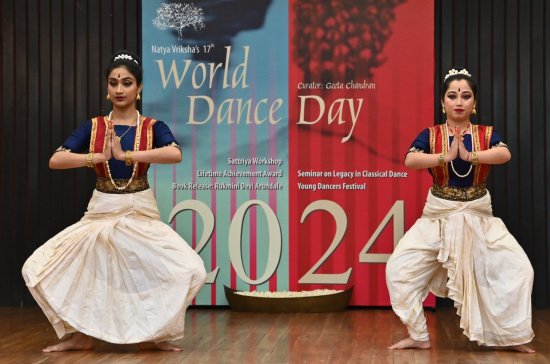 Sattriya workshop This year the 5th Natya Vriksha Lifetime Achievement Award was conferred upon the well-known dance critic and author Leela Venkataraman on the inaugural day. This was followed by the book release 'Rukmini Devi Arundale - Arts Revivalist and Institution Builder' authored by Dr.V. R, Devika and published by Niyogi Books. The book was launched by Ashok Vajpeyi, the Hindi poet and critic, who also spoke about the book. The workshop on 'Movement Techniques in Sattriya Dance' led by Dr. Prateesha Suresh was held during the morning hours on both days. It was enthusiastically attended by dancers from all dance forms. Natya Vriksha has been celebrating the WDD with the 'Young Dancers Festival' showcasing young talents, right from the beginning of this laudable initiative. This year, the Young Dancers Festival featured Bharatanatyam by Vaishnavi Srinivasan and Nivedha Harish, disciples of Roja Kannan, and Kathak by Divya Goswami, disciple of Yogini Gandhi and the Late Guru Munnalal Shukla on the inaugural evening and Mohiniyattam by Thomas Vo Van Tao from France, a gifted disciple of Neena Prasad and Bharatanatyam by Meera Sreenarayanan, disciple of Indira Kadambi on the second evening. An invigorating seminar on 'Legacy in Classical Dance' with panelists like Dr. Anita Ratnam, Guru Sadanam Balakrishnan, Roja Kannan, Dr. Neena Prasad, Indira Kadambi and Prateesha Suresh was moderated by Geeta Chandran. Legacy in classical dance was discussed at length from the Guru-Shishya Parampara of the olden days to the institutionalized teaching of the present times, to the latest query if legacy has any relevance for the young today. 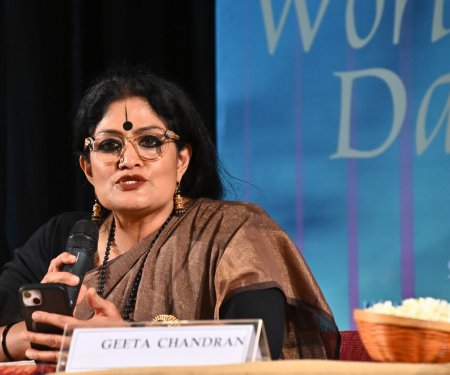 Geeta Chandran Guru Sadanam Balakrishnan, the well-known Kathakali guru and performer said that after training for twelve years strictly following the legacy, his Guru gave freedom to his disciples to improvise on their own, but cautioned, "Don't make change for the sake of change, let it happen on its own. Just sow the seed, let the flower bloom on its own." Roja Kannan remembered that both her teachers, Adyar Lakshman and Kalanidhi Narayan brought their legacies of learning. Lakshman Sir had spent three decades in Kalakshetra, so he continued the holistic pedagogy of teaching vocal, mridangam, nattuvangam, and dance to the best of the student's ability graciously and generously. Kalanidhi Maami would say, "Go with the flow, natural organic flow, don't resist yourself." Every style has a different graph of evolution. Neena Prasad spoke about the correct proportion of auchitya in Mohiniyattam and talked about the legacy of the two Gurus she learned from at Kalamandalam, Guru Satyabhama and Kalyanikutty Amma, who focused on making the Mohiniyattam body and the Mohiniyattam brain. Kalamandalam Kshemavathi was quite open-minded. Neena reiterated, "While teaching I find the biggest problem is they don't read literature, so the aesthetics that comes from feeling the literature is missing and so is the languid Nayika which has a lyrical quality!" Dr. Anita Ratnam has done different things including dance and theatre. Speaking about her legacy she said, "Coming from a family of free thinkers and pioneers, I started learning dance with Raji Narayan who gave me the joy of dance. Adyar Lakshman gave me a beautiful Araimandi and, openness in learning. I went ahead with an open mind exploring different things, along with the dance. Students trained under different gurus come to me to become a part of my productions. I don't want to change their styles but they have to dance my choreography. It takes them three years of training, where they learn a lot. They bond, and take responsibility because they are the stakeholders in the work they are collaborating with me, and I give them credit for that. My legacy would be digital because archiving and documentation are important to preserve a legacy. Writing, speaking, podcasts et al are part of my passing on the legacy. I digitalize every single aspect of my major productions; the process of choreography, costume designing, the weave, colour of the fabric to light and sound designing, and music." Indira Kadambi talked about the legacy of her gurus and shared that Guru Narmada gave her the joy of learning dance. "We did what we thought would look beautiful. Guru Narmada taught us how to approach the subject." Prateesha Suresh started learning Sattriya in the Sattra of Majuli, Assam and felt something was missing. "I found the missing link when I went to Kalakshetra," she continued "In Majuli island Sattra the dance was in the Natya tradition. Kalakshetra gave me a new lens to look at Sattriya while being true to the tradition of Shrimanto Shankardeva." Geeta Chandran added her insights and inputs while ably moderating the seminar. 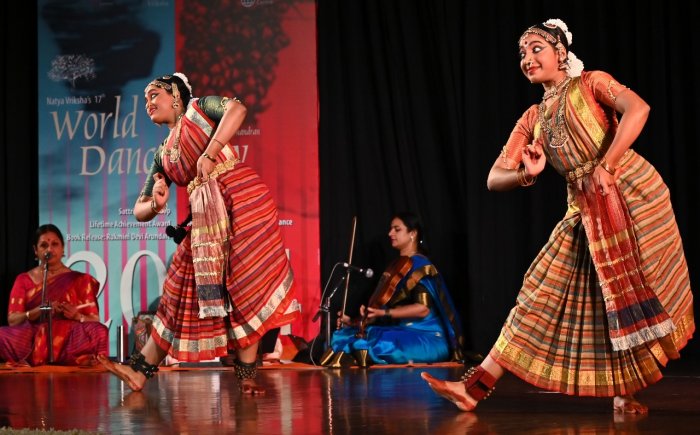 Vaishnavi Srinivasan and Nivedha Harish The Young Dancers Festival on both evenings attracted a maximum crowd. The inaugural evening started with the sparkling Bharatanatyam duet by Vaishnavi Srinivasan and Nivedha Harish, disciples of Roja Kannan. They opened with the Panchadeva Stuti invoking Ganesha, Muruga, Shiva, Devi, and Vishnu, set to Ragamalika and Talamalika. It was followed by Husseni Swarajathi about the khandita nayika, based on the research work of Lakshmi Viswanathan on the Thanjavur tradition of hereditary artists. The original composition of the Tanjore Quartet was choreographed by Lakshmi herself, with charanams choreographed by Roja Kannan. The immaculate synchronization of both the dancers and their crisp execution of jathis got them repeated applause. 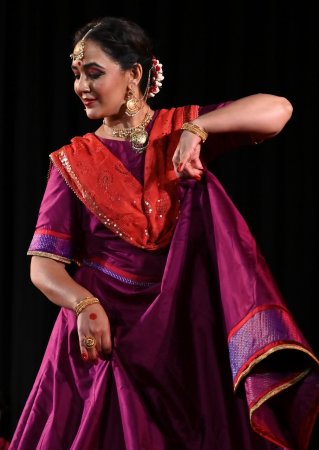 Divya Goswami The Kathak presentation by Divya Goswami, a brilliant disciple of Yogini Gandhi and Guru Munnalal Shukla, was the other attraction of the inaugural evening. Opening with 'Aquidat' as a Mangalacharan, on the Punjabi poem of the Sufi poet Fazal Shah, Divya presented the choicest composition of Guru Munnalal Shukla in Teentala comprising Thaat, Aamad, Tode, Tukde, Paran, Gat-Nikas et al that showcased her brilliance in the technical aspect of Kathak. Divya presented a riveting dance theatre on 'Sohini Mahiwal', based on the poetry of Fazal Shah for her abhinaya segment. The music for this was composed by Bangalore based D. Praveen Rao, who also accompanied her on tabla, leading the live orchestra. If the Nritta Paksha astonished the audience with her brilliance, the intense abhinaya on the tragic love story got many eyes moistened. Divya gave a superb performance with abhinaya inputs by Kamalini Dutt but for her prolonged introduction to the well-known love story of Punjab and the elongated drowning scene that needs drastic editing. 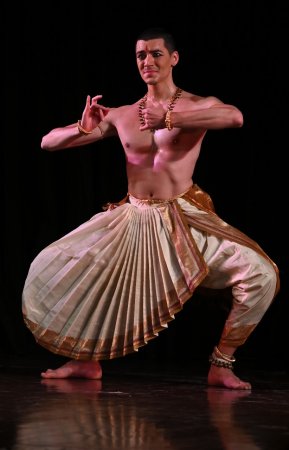 Thomas Vo Van Tao The second evening of the Young Dancers Festival opened with the lyrical Mohiniyattam performance by Thomas Vo Van Tao, the enchanting male dancer from France, who is trained under Dr. Neena Prasad. Right from the invocatory Cholkettu for Ganapathi, in Gambhira Nattai, set to misra triputa talam, Tao captivated the audience with his elegant demeanour and immaculately swaying body movements. The Pada Varnam, a composition of Changanacheri Madhavan Namboothiri in Shankarabharanam set to adi tala was dealt with absolute conviction, with command on both the graceful body movements and convincing abhinaya. The Swathi Thirunal composition about the virahini Nayika sharing her feelings with her 'Sakhi', was followed by the concluding Thillana in Tilang, set to rupaka talam. The excellent live orchestra, despite the conspicuously missing chenda, enhanced the poetic performance with Neena Prasad on nattuvangam, Ramamurthy Kesavan on mridangam, Ananda Mura on vocals, and V.S.K. Annadurai on violin. The two-day festival concluded with the Bharatanatyam performance by Meera Sreenarayanan, a disciple of Indira Kadambi. Opening her recital with the invocatory Devi Meenakshi Stuti "Meenakshi Karuna Tarangitakshi" based on raga Durga, Meera continued with Khandajati Alarippu. The Todi Varnam in rupaka talam, a composition of Shivananda (of the Thanjore quartet), showcased Meera's prowess at both nritta and abhinaya. Meera concluded her Bharatanatyam recital with a Tillana in Simhendramadhyam, composed by Prof. C.V. Chandrashekar. The capable curator of the World Dance Day and founder of Natya Vriksha organizing the two-day event, Geeta Chandran summarized, "Natya Vriksha wasn't born solely from a love of dance, but from a need to create a community - a space where dancers of all styles can come together, share their journeys, and support one another. It's about breaking down barriers, empowering young talent, and celebrating the incredible artists who have dedicated their lives to this art form". The WDD celebration serves this purpose! LASYA UTSAVA Kalaagat Niranjana Foundation of Kathak dancer Yamika Mahesh celebrated the WDD with 'Lasya Utsava', a colourful bouquet of dance performances by the established dancers of various Indian classical dance forms. Kalaagat Niranjana has been spreading awareness about the aesthetics and values of our art and culture by educating the youngsters in music, dance, visual arts, theatre and organizing cultural programs and workshops of these art forms. They invited top artists in their 'Samanvay Series' to motivate people during the pandemic period. 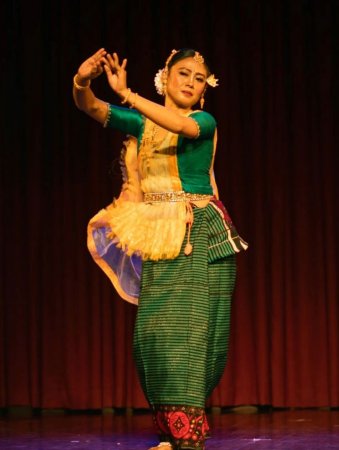 Babina Chobungham 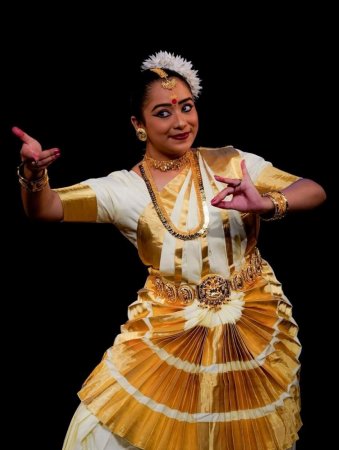 Hritika Aneesh Kalaagat Niranjana showcased a rich tapestry of Indian classical dance tradition on the World Dance Day, by presenting dynamic classical dancers of Delhi at Triveni Kala Sangam auditorium. The celebration opened with a Manipuri dance recital by Babina Chobungham, who has completed her doctoral research on Manipuri Dance recently at the JNU. Babina presented Radha-Krishna Abeer Khel and Radha Abhisara. Choreographed by her Guru N. Abusana Devi, the piece depicted the Abhisar of Radhika when she goes in the dark of night to meet her beloved Krishna. The recorded song had the typical high-pitched voice in raga Khamaj, accompanied by khol when Babina enacting Radha, dressed delicately in green Phenek and white Odhani goes for the Abhisara. The dance piece also had vachika abhinaya interspersed in between the music, with dialogue delivery. The Mohiniyattam by Hritika Aneesh, a disciple of Dr. Deepti Bhalla, opened with Ganapathi Stuti, followed by Mukhachalam. The recorded music composed by the Late Leela Omcheri in raga Yamuna Kalyani played on violin, veena accompanied by chenda and maddalam enhanced the choreography by Dr. Deepti Omcheri Bhalla. 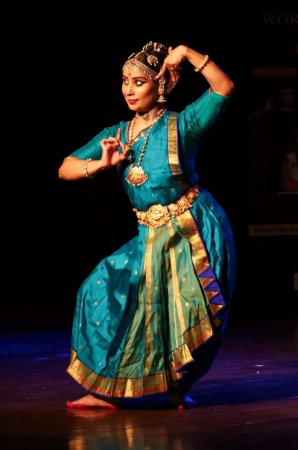 Ayana Mukherjee 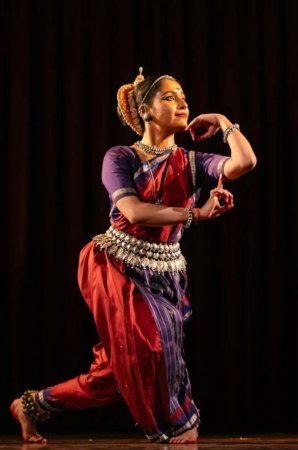 Shalakha Rai Ayana Mukherjee the graceful Kuchipudi dancer trained under Gurus Vanashree and Jayarama Rao presented the Jayadeva ashtapadi "Radhike tava virahe Keshava..." from Geeta Govinda. This was to be followed by a Tillana but the announcer never realized that the Tillana was remaining when she invited the next dancer. This came as a surprise to the end of the program with a bonus, as a duet of Bharatanatyam and Kuchipudi! Odissi was presented by Shalakha Rai, a dedicated disciple of Guru Madhavi Mudgal. She opened her Odissi recital with Gunakari Pallavi, which sounded like the Hindustani Dhani raga. After convincing of her competence in Odissi grammar, she went ahead with abhinaya on a Champu Kavya of Kavisurya Baldeva Rath and an Odia song, both choreographed by Guru Kelucharan Mohapatra with music by Bhubaneshwar Mishra. Ragini Maharaj, the gifted granddaughter of Pt. Birju Maharaj presented three items, all written, composed, and sung by the Late Pt. Birju Maharaj, with the mudra (pseudonym) of Brijshyam. The opening song was a Bhajan, the second "Barnat chhavi Shyam Sundar" depicted the beauty of Krishna and the third one incorporated the technical aspect of Kathak defining the use of Bhrikuti (eyebrows), Nayan (eyes), Adhar Aru Greeva (lips and neck), Hasta (hand gestures), Vaksha (torso) aru Kati Pradhan Ang Banaye, all those body parts that help beautifying the Ang. Set to Jhaptala of ten beats time cycle, the song also had Pheri, Palta, Gat Nikas interwoven in the song that ended with a sparkling Tihai! 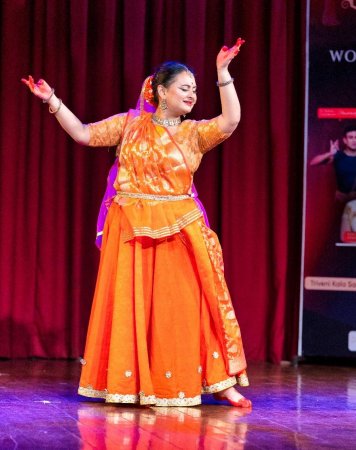 Ragini Maharaj 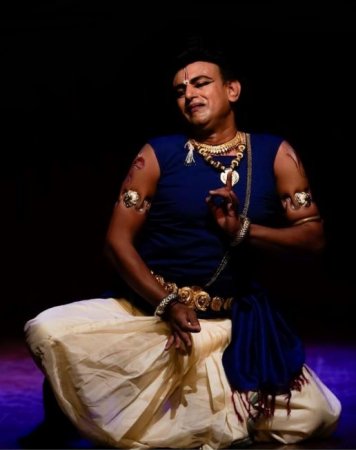 Dr. Sridhar Vasudevan Dr. Sridhar Vasudevan's Bharatanatyam recital came as the concluding presentation of Lasya Utsava. A brilliant disciple of Vyjayantimala Bali, Vasudevan is a versatile dancer, singer, composer, choreographer, and scholar who also trained in Kathakali under Guru Sadanam Balakrishnan, Chhau under Guru Shashadhar Acharya, Carnatic vocal under the tutelage of Prof. Radha Venkatachalam and philosophical research under Kamalini Nagarajan Dutt. He chose the composition of Muthuswamy Dikshitar "Sri Parwati-Parameshwarau Vande" in raga Dhauli to present the concept of Srividya Tantra through Ardhanarishwara, in a Varnam format interspersed with complicated jathis. The 'Bhava Bhangima' of both masculine and feminine energies was depicted with the Natya Vrittis of Tandava and Lasyanga. After this mesmerizing Bharatanatyam recital, he invited Ayana Mukherjee to dance the remaining Tillana of her performance, as a duet with him. The scintillating Sindhu Bhairavi Thillana duet of Bharatanatyam and Kuchipudi by Vasudevan and Ayana reached the Lasya Utsava to its climax. GURU PRANAM UTSAVA Guru Pranam Utsava, a Festival of Music and Dance was organized on May 17 by the Odissi exponent Jyoti Srivastava and her Vaishali Kala Kendra, in memory of her Guru Srinath Raut, at the Habitat Centre, Delhi. 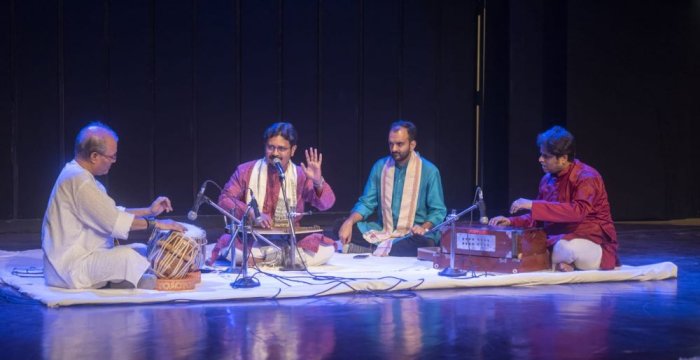 Anirban Bhattacharya and group The well-conceived festival opened with a Hindustani vocal recital by Guru Anirban Bhattacharya and his disciple Siddharth Kishore. The chosen raga was Yaman, one of the most melodious ragas of the evening to start with. The vocal recital opened with Siddharth rendering the Guru Vandana "Dhyanamulam Gurorvakyam...Mokshamulam Gurorkripa" in the free-flowing aalap of the raga, with Jyoti's students offering floral tribute to the photo of Guru Shrinath Raut simultaneously. Siddharth continued with the popular Bandish of raga Yaman "Main vaari vaari jaaun pritam pyare" set to teentala accompanied on tabla by Jagannath Roy and on harmonium by Sumit Mishra. The rendition of the complete composition with Sthai and Antara was followed by a variety of Sargam Taans. Siddharth was also there keeping the taal with his hands while his Guru Anirban Bhattacharya performed various compositions. Anirban Bhattacharya opened his vocal recital with raga Bihag starting with a Jhaptala composition "Chinta na kar re", elaborating the raga at great length. This was followed by a teentala composition "Ab toh rat laagi" composed by Ud. Bade Ghulam Ali Khan. The next composition "Dhoom dhaam" attracted discerning listeners with its teasing taal pattern in teental. Anirban concluded his performance with a Tarana in the same raga Bihag, set to drut ektala. The vocalist inspired the tabla and harmonium accompanists to give their best. 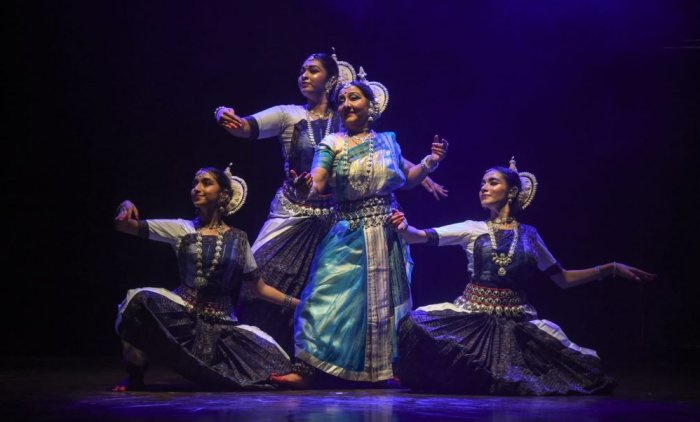 Vaishali Kala Kendra The group dancers of Vaishali Kala Kendra took the stage next and presented a thematic 'Varsha Pallavi' on raga Megh. The participating dancers Kaori Naka, Pankhuri Srivastava, Khyati Raut, and Sanvi Rastogi were the senior disciples of Jyoti Srivastava. This was followed by an Odia song "Ghan ghan rasa barasi laagi," an attractive solo abhinaya by Jyoti, continuing with the celebration of Varsha Ritu, the monsoon season. Dr. Y. Theba Devi, the Manipuri dancer, presented Vasakasajja. Love, longing, and devotion were the main bhavas in 'Radha Abhisara' when the dancer crossed the dense forests, yearning for her beloved. The Nayika's anticipation to meet her lover turns into disappointment when she doesn't find him there. 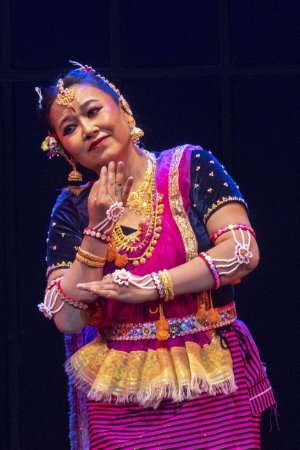 Y. Theba Devi 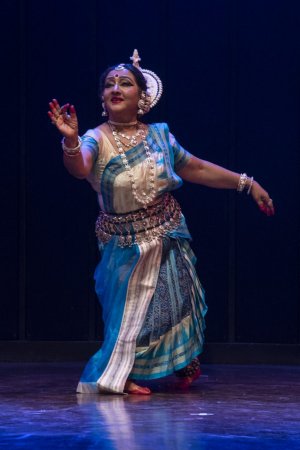 Jyoti Srivastava The pathos of separation continued with the Jayadeva ashtapadi "Raase Harimiha...." as a solo abhinaya piece by Jyoti in Odissi, preceded by the shloka "Viharati vane Radha". Sangini Kumar, a senior disciple of Guru Kiran Segal, presented "Jago Maheshwara" written by Kalicharan Patnaik and choreographed by Guru Mayadhar Raut. Dashavatar composed in Ragamala set to jhaptala was the concluding choreography of Guru Srinath Raut, performed by Jyoti and her disciples. Vaishali Kala Kendra presented the 36th Guru Srinath Raut Samman 2024 to Kamalini Dutt for her research and significant work in 'Revitalizing Natya Shastra'. 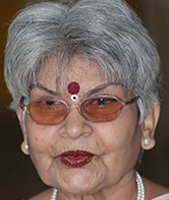 Manjari Sinha has an M.A. in Sanskrit and Music, and Sangeet Prabhakar in vocal, tabla, sitar and Kathak dance. She has regular columns in national dailies as a music and dance critic. |